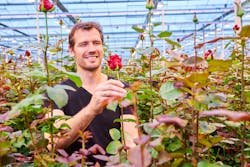The question has risen again: Will greenhouses have enough heat if lit by energy-efficient LED rather than by conventional HPS (high-pressure sodium) grow lights? This time, a leading rose grower in Holland decided to retain HPS to maintain a warm indoor climate, while adding LEDs to boost light levels and optimize spectral tuning.
And according to LED lighting provider Signify, the method paid off unusually both in yield and in quality — Signify claims it’s normally one or the other for the type of roses in this instance — at an installation by grower Marjoland in Waddinxveen.
Marjoland claims to be Holland’s largest rose grower, with a 20-hectare farm and five varieties. Last October, in a one-hectare section dedicated to Red Naomi roses, it added a number of Signify’s Philips GreenPower linear LED toplights to join the existing HPS, creating a mix of about two-thirds HPS and one-third LED. The LEDs provide a greater light output and are optimized with a spectral recipe tailored to the roses.
“With 20% more light we have a significant higher production, with a more uniform quality,” said Marjoland general director Daniel van den Nouweland. “With the light spectrum especially designed for roses, we’re able to lower our energy consumption and at the same time deliver a more homogeneous quality of roses to our customers all year round.”
If the results were so good, would they not have been even better with a 100% LED treatment replacing all the HPS? Why did Marjoland leave the majority of toplights as HPS?
The answer lies in the irony that LEDs’ light-emitting efficiency can work against the technology. The efficiency indeed helps reduce energy bills and CO2 emissions. But the efficiency also means the LEDs emit far less heat than do HPS lights, in which electricity converts to fewer photons and more heat. And heat is an asset in a greenhouse.
“Rose growers, who need a certain amount of heat, do not feel comfortable enough yet to get rid of the HPS lights completely,” a Signify spokesperson told LEDs Magazine.
The same concern came up last year at an indoor tomato farm in Belgium, where Tomato Masters took extra measures to retain heat as it built a new 5.4-hectare facility lit entirely with LEDs provided by Plessey Semiconductors (Plessey has since sold its grow light division, now called Hyperion Grow Lights).
At rose grower Marjoland, other factors might have also entered into the decision to only partially install LEDs, such as capping upfront costs.
“Marjoland wanted to reuse their existing HPS installation, because it’s still very good,” the Signify spokesperson told LEDs. “So now they’re having all the benefits of using LEDs with a smaller and smarter investment.”
Neither Signify nor Marjoland is revealing the exact spectral recipe emitted by the LEDs, which contains “a lot of red light and a bit of blue, white, and far red,” the spokesperson told us.
The LED lights buoyed the greenhouse’s lighting level to 330 µmol/m2/s, from what had been 230 µmol/m2/s.
Prior to the Marjoland installation, Signify worked with Holland’s Wageningen University and with Wageningen-based research group Delphy to develop the recipe, which Signify said improves leaf quality, bud size, length, number of stems, and thickness.
“The buds of the roses are over 50 mm in length and can be preserved for more than 10 days during winter,” Signify said.
MARK HALPER is a contributing editor for LEDs Magazine, and an energy, technology, and business journalist ([email protected]).
For up-to-the-minute LED and SSL updates, why not follow us on Twitter? You’ll find curated content and commentary, as well as information on industry events, webcasts, and surveys on our LinkedIn Company Page and our Facebook page.






